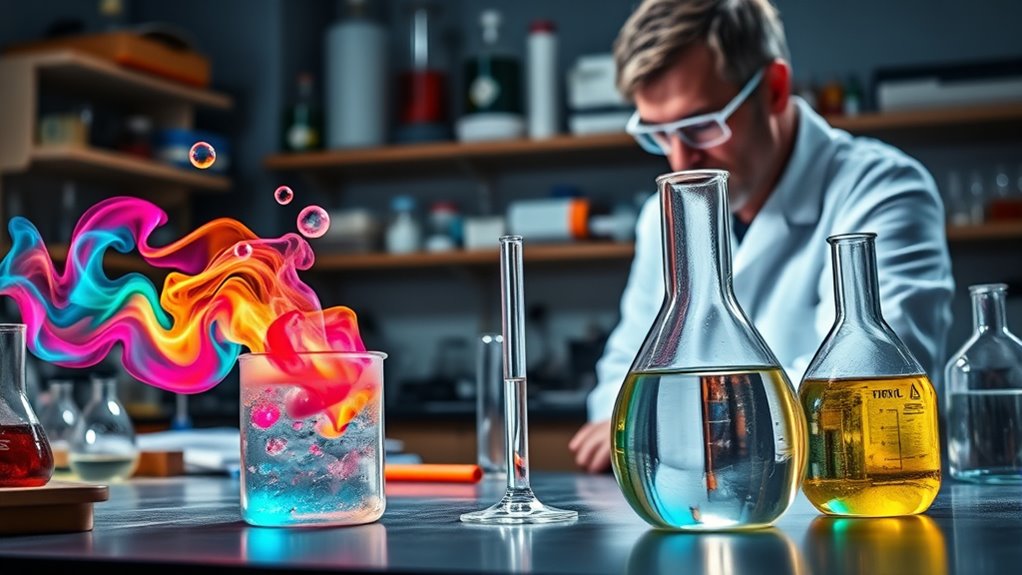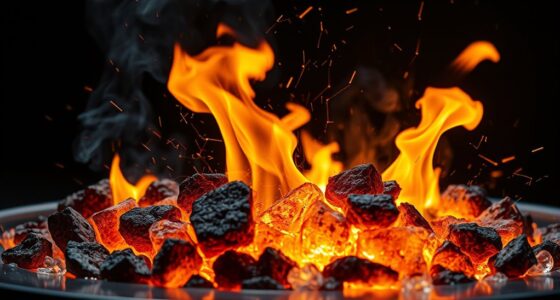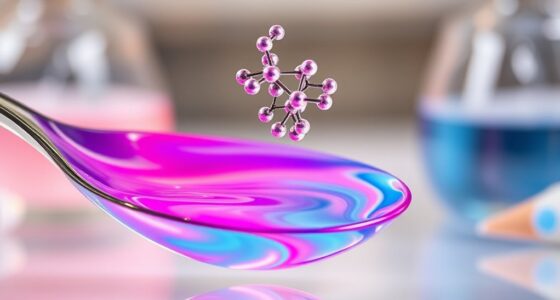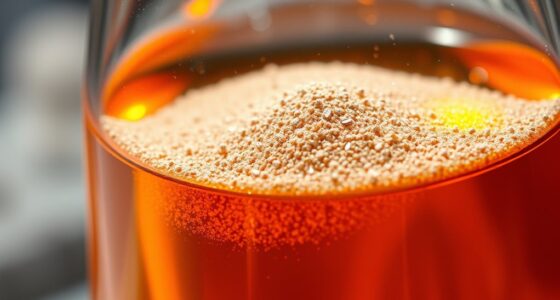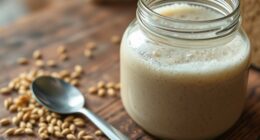In chemical reactions, thermodynamics shows which products are most stable, but kinetics determines how fast they form. Even if a product is thermodynamically favored, a high activation energy can make the reaction slow or practically impossible without a catalyst. Conversely, reactions with low activation energy happen quickly, even if the products aren’t the most stable. If you want to understand which factor actually controls a reaction’s outcome, keep exploring these key differences.
Key Takeaways
- Thermodynamics predicts the most stable products, but kinetics determines how quickly they form.
- A reaction can be thermodynamically favorable yet kinetically hindered, preventing immediate formation.
- Kinetic control favors products formed via lower activation energies, regardless of thermodynamic stability.
- Catalysts can alter reaction pathways, shifting the balance between kinetic and thermodynamic outcomes.
- Ultimately, thermodynamics decides “who wins” in stability, while kinetics influences the reaction’s speed and feasibility.

Understanding the difference between kinetics and thermodynamics is essential when studying chemical reactions. These two concepts determine how reactions proceed and which products form, but they focus on different aspects.
Thermodynamics tells you whether a reaction can occur spontaneously by examining the overall energy change, while kinetics explains how fast the reaction happens and the specific routes it takes. When exploring reaction pathways, you’ll see that energy profiles play a pivotal role. These energy profiles graphically depict the energy changes throughout the reaction, highlighting activation energies, intermediates, and the relative stability of products and reactants.
Thermodynamics predicts if a reaction is spontaneous; kinetics shows how quickly and through which steps it proceeds.
By analyzing energy profiles, you can predict whether a reaction is thermodynamically favored or kinetically accessible. Reaction pathways are like maps that chart the step-by-step process a reaction follows from start to finish. They reveal the sequence of molecular events, including the formation of transition states and intermediates.
Even if a reaction is thermodynamically favorable—meaning the products have lower energy than the reactants—it might still be slow if the activation energy barrier is high. This is where kinetics becomes vital. It determines whether the reaction pathway is accessible within a practical timeframe.
For example, a reaction with a steep energy profile and a high activation energy may take years to proceed, despite being thermodynamically favorable. Conversely, a reaction with a lower activation energy will happen faster, even if the overall energy change is modest.
When considering energy profiles, think of them as topographical maps showing hills and valleys. The highest point on this map is the transition state, representing the energy barrier that must be overcome for the reaction to proceed.
If this barrier is too high, the reaction becomes kinetically hindered. The reaction pathways are influenced by these energy profiles, guiding the formation of specific products under certain conditions. Additionally, reaction rates are affected by temperature and catalysts, which can help lower activation energies and make kinetically hindered reactions more feasible. Lowering the activation energy can turn a slow, kinetically hindered reaction into a faster process, making it more practical to achieve desired outcomes. The thermodynamic aspect tells you which valleys (products) are more stable, but the reaction pathway determines if you can reach them at a reasonable rate. Sometimes, reactions are kinetically trapped in local minima, preventing formation of the most stable products despite their thermodynamic favorability.
Frequently Asked Questions
How Do Catalysts Influence Reaction Kinetics Without Altering Thermodynamics?
You might wonder how catalysts influence reaction pathways without changing thermodynamics. Catalysts work by providing alternative pathways with lower energy barriers, speeding up reactions without affecting the overall energy change.
They help you reach the *crossing point* more easily, increasing reaction rates. This means the thermodynamic outcome stays the same, but the reaction happens faster because the catalyst alters the reaction kinetics by modifying the energy barriers along the pathway.
Can a Thermodynamically Favored Reaction Be Kinetically Hindered?
Imagine a road full of scenic views but blocked by a fallen tree; even if the destination is desirable, the journey is hindered. Likewise, a thermodynamically favored reaction often has a low reaction energy, making it spontaneous. However, the reaction pathways can be blocked by high energy barriers, causing kinetic hindrance.
What Role Does Activation Energy Play in Reaction Rates?
Activation energy acts as an energy barrier that determines how quickly a reaction occurs. When you lower this barrier, the reaction speeds up because more molecules have enough energy to overcome it.
Conversely, a high activation energy slows down the reaction, making it less likely to happen quickly. So, your reaction rate depends heavily on the size of this energy barrier, directly influencing how fast the reaction proceeds.
How Do Temperature Changes Affect Kinetics Versus Thermodynamics?
When temperature changes, it impacts reaction mechanisms by providing more energy to overcome energy barriers, speeding up reaction rates.
Higher temperatures make it easier to surpass activation energy, enhancing kinetics.
However, thermodynamics, which determines whether a reaction is spontaneous, depends on energy differences between reactants and products.
Are There Real-World Examples Where Kinetic Control Overrides Thermodynamic Stability?
You might encounter situations where kinetic control overrides thermodynamic stability, especially when reaction pathways involve high energy barriers that slow down the process.
For example, in the synthesis of certain pharmaceuticals, the desired product forms faster under kinetic control despite not being the most stable compound thermodynamically. This occurs because the reaction follows a pathway with lower energy barriers, favoring quicker formation over ultimate stability.
Conclusion
In the end, it’s a coincidence that the faster, easier path often leads you to the less stable product, while the more stable one takes longer to form. You might start with a quick reaction that seems to “win,” but given enough time, the thermodynamic favorite quietly takes over, like a calm tide shaping the shore. So, in your reactions, remember: speed isn’t always victory—stability might just be the quiet, ultimate winner.
